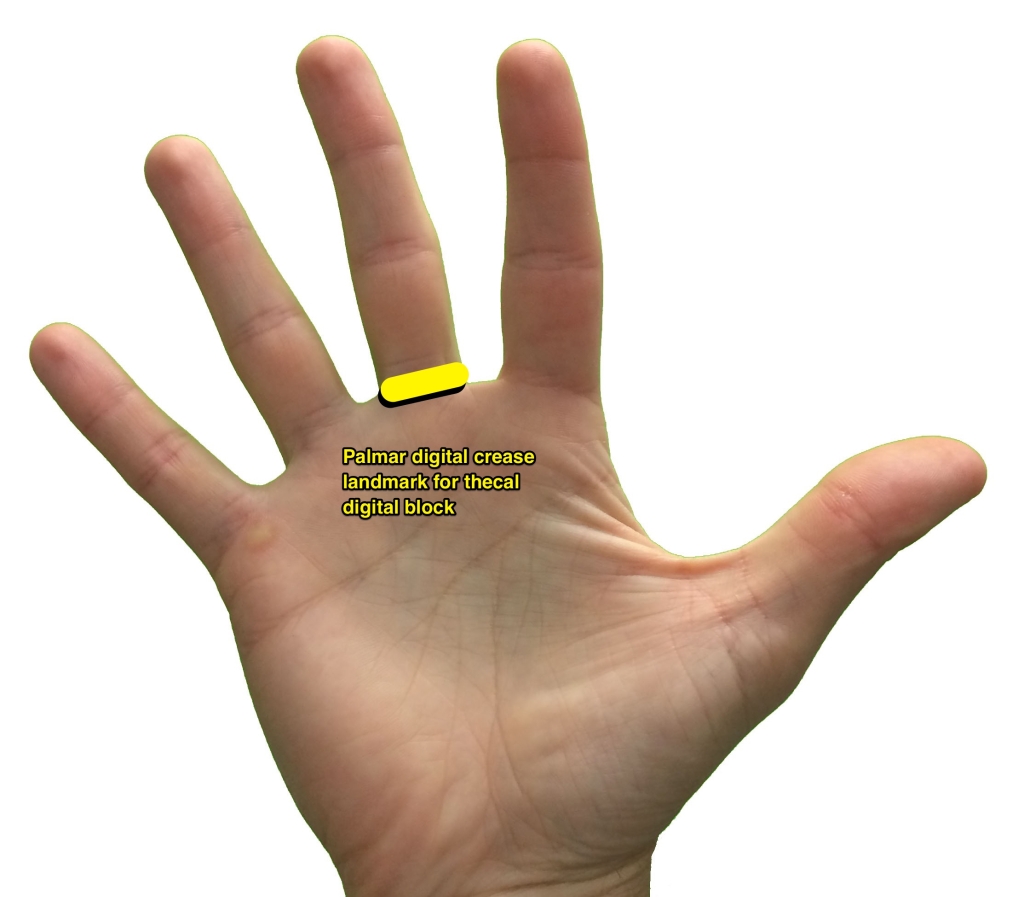This post was written by Meredith Posner Shuch, a senior resident at Cincinnati Children’s Hospital Medical Center as a component of the Emergency Department Procedure Elective.
Digital nerve blocks provide anesthesia for many procedures in the ED, including finger lacerations, paronychia drainage, finger reductions, and nail bed repairs
The transthecal digital block technique was first introduced by Chiu in 1990 [2]. This technique involves a single palmar percutaneous injection of lidocaine into the space of the flexor tendon sheath. This results in compete anesthesia of the digital nerves of the finger via centrifugal anesthesia diffusion. In addition to requiring only one injection, this technique is also beneficial because it reduces the risk of trauma to the neurovascular bundle relative to the traditional technique. A potential difficulty of this procedure is the identification of the flexor tendon sheath by palpation alone [3]. To make this procedure more accessible to medical staff of varying experience levels, Whetzel et al modified the procedure to make the injection site a visible (rather than palpable) landmark. In Whetzel’s approach, the center of the palmer digital crease on the volar surface is identified as the injection site (see image below). The hand is cleaned appropriately with betadine or chlorhexidine and a 25 gauge needle is inserted at the palmar digital crease penetrating through the flexor tendons to the bone. The needle is then withdrawn slowly while applying gentle pressure to the plunger of the syringe. Once the needle is in the tendon sheath space, the lidocaine flows easily [3]. They recommend injecting 2 ml of lidocaine. It is also important to wait for the anesthetic to take full effect. I recommend waiting at least 7 to 10 minutes after the injection, then reassessing for satisfactory anesthesia.
This technique seems simple, but is it as effective as the traditional digital nerve block? Hill et al performed a prospective, randomized controlled blinded study (on adults) comparing the transthecal and traditional digital block methods and looked at outcomes such as pain during infiltration and time to achieve anesthesia [4]. Each patient received a transthecal block in one hand and a traditional block in the other hand. All blocks were performed by the same investigator. Pain from procedure was recorded by the subject on a 10 cm visual-analogue scale. Time to loss of pinprick sensation was measured. A total of 162 blocks (81 of each type) were performed. All blocks were found to be successful and there were no complications. Mean pain score was slightly higher in the transthecal block compared to traditional block (1.7 vs. 1.4 on a scale of 0-10 (p=0.20) and time to loss of pin prick sensation was also slightly longer in the transthecal block (188 seconds vs. 155 s, p < 0.01). Although statistically significant, the small difference of a 0.3 higher pain score and 36 second longer time for anesthesia are unlikely to be considered clinically important. They concluded that the transthecal block was clinically equal to the traditional digital block. Based on this evidence and the ease of only one injection, you may want to consider the transthecal approach the next time you need to perform a digital block in the ED.













[…] know you don’t necessarily need to do two local anaesthetic injections for a digital block? One – in a slightly different place – may be […]